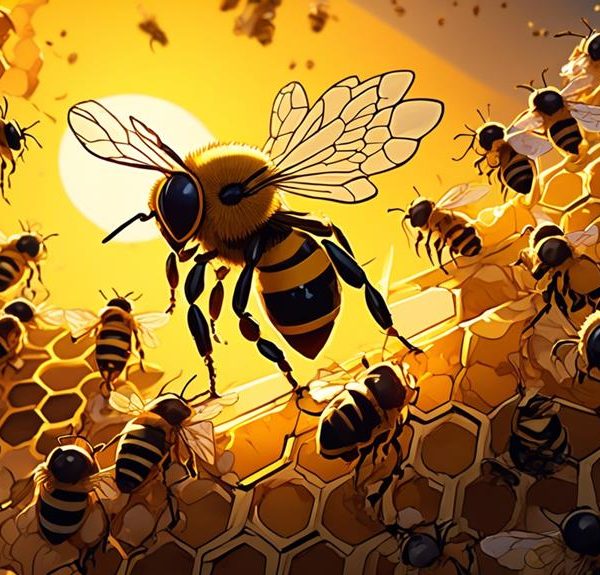Uncover the surprising truth about bees' biting abilities and how they compare to their infamous sting.
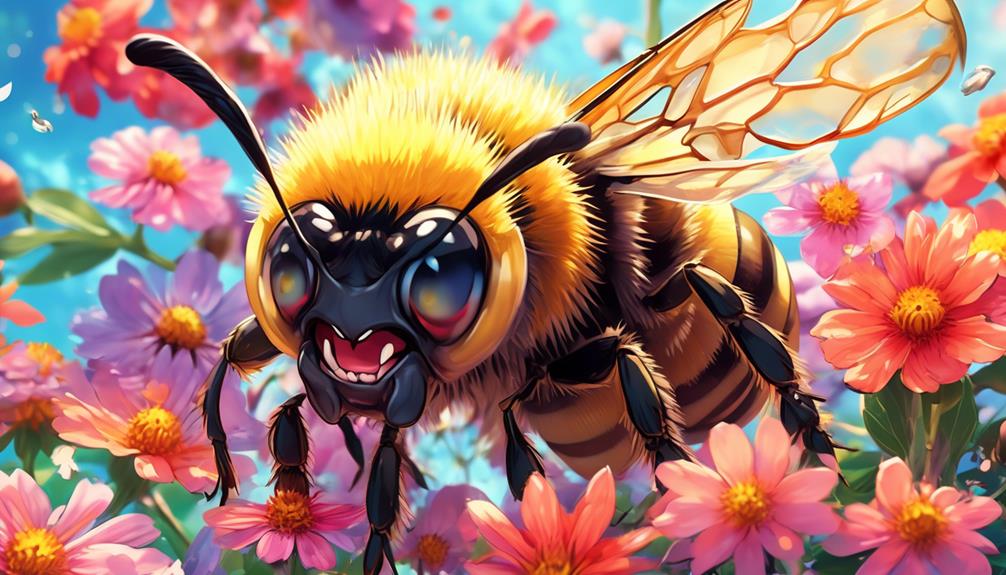
Can Bees Bite Instead of Sting?
Invoking the curious case of Dr. Dolittle, you might wish you could chat with a bee. You'd ask, 'Can you bite as well as sting?' It's a question that might have buzzed around in your mind for a while.
You're familiar with the bee's sting, of course – it's the reason you give these little critters a wide berth when they're bouncing around your garden. But what about a bee's ability to bite? Can these tiny creatures clamp down with their jaws like we do?
Let's take a closer look and find out. The answer may surprise you.
Key Takeaways
- Bees have two sets of jaws, called mandibles, which they use for biting.
- Bee bites are not harmful to humans and do not cause pain.
- Bee stings cause more severe symptoms due to the venom injected into the body.
- Bees only sting or bite when they perceive a threat to their hive or themselves.
Understanding Bees' Anatomy

To fully grasp why bees can bite rather than sting, you'll need to delve into the intriguing complexity of their anatomy. Unlike many species of insects, bees have two sets of jaws. The outer set, called mandibles, aren't just for consuming nectar. They're also responsible for the biting action, which can be quite strong, despite the bee's diminutive size.
Bees also have a stinger, located at the end of their abdomen. It's not a weapon they wield lightly. When a bee stings, it often results in its death as the stinger is typically left behind, causing fatal injury to the bee. This is why bees usually resort to biting before stinging.
However, the bite of a bee isn't typically capable of breaking human skin, hence it's not painful for us. It's a different story for smaller insects though. For them, a bee's bite can be a formidable defense mechanism.
It's important to note that not all bee species possess the same anatomical features. The stingless bees, for instance, can only bite. Understanding this aspect of bee anatomy sheds light on their behavior and how they interact with their environment.
The Mechanism of Bee Sting
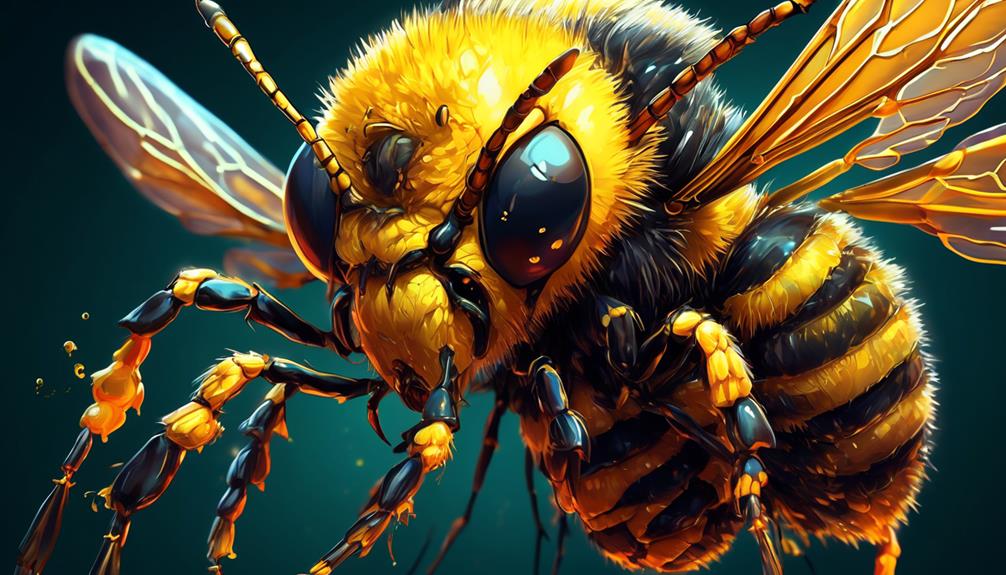
When a bee decides to sting, it's committing a final, sacrificial act in defense of its colony, and the mechanism behind this is quite fascinating. You see, a bee's stinger isn't just a sharp point; it's a complex apparatus equipped with barbs, a venom sac, and muscles to drive the stinger in and pump venom.
The moment a bee stings, its barbed stinger anchors into your skin, and it can't be easily pulled out. It's a one-way trip, and the bee's abdomen is torn away in the process, leading to its death. The stinger isn't just a weapon – it's a pump. Even after the bee has flown away, the muscles continue to contract, driving the stinger deeper and pumping venom into your body.
The venom, called apitoxin, is a cocktail of proteins and peptides that cause pain and inflammation. It also contains an alarm pheromone that attracts other bees, signaling them to defend their hive. So, a bee sting isn't just painful, it's a call to arms.
This is the intricate, self-sacrificing mechanism of a bee sting.
Exploring the Bee Bite Phenomenon

Contrary to popular belief, bees can indeed bite you, a lesser-known behavior that serves an entirely different purpose than their sacrificial sting. Some bees, like the honeybee, can bite as a way to communicate danger or threat to the rest of their hive. They release a pheromone, 2-heptanone, which signals other bees to stay away. Interestingly, the bee bite isn't harmful to humans, you won't even feel it.
Let's delve deeper into this phenomenon with a comparison table:
Bee Sting | Bee Bite |
|---|---|
Used as a defense mechanism | Used for communication within the hive |
Causes pain and can be harmful to humans | Doesn't cause pain and isn't harmful to humans |
The stinger is left in the skin and the bee dies | The bee survives after biting |
You're now equipped with the knowledge that bees, under certain circumstances, can bite instead of sting. It's a fascinating aspect of their behavior, showing how intricate and complex these small creatures can be. Next time you come across a bee, remember, it's not always about the sting!
Comparing Sting and Bite Effects
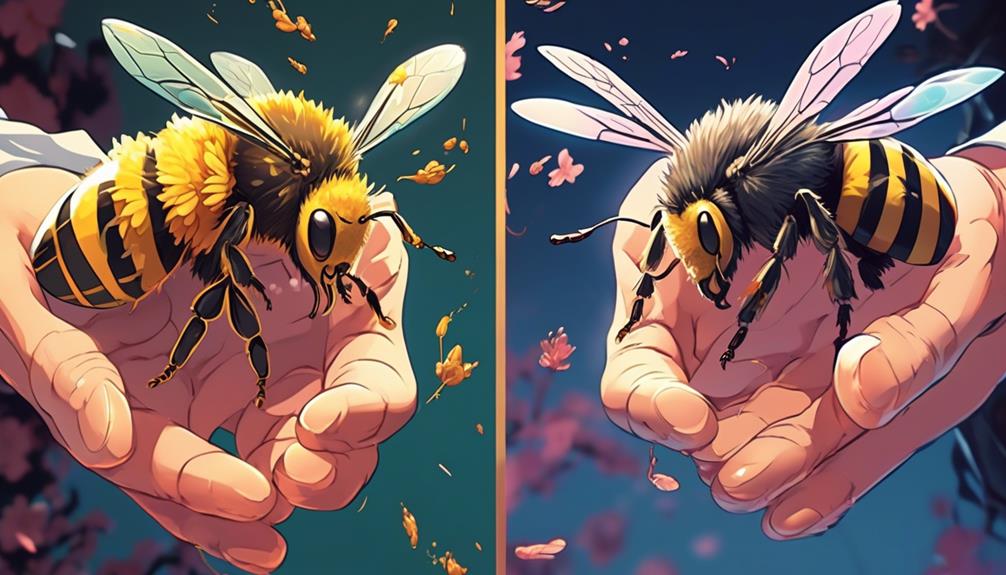
In comparing the effects of a bee sting and a bee bite, you'll find marked differences in physical reactions and subsequent consequences.
A sting inflicts far more severe symptoms, typically due to the venom injected into your body. You'll experience a sharp, burning pain and redness, which could escalate into a systemic allergic reaction, known as anaphylaxis, in some individuals. This could lead to difficulty breathing, swelling of the face, rapid pulse, and in extreme cases, can be fatal.
Conversely, a bee bite is rare and usually occurs when the bee feels threatened. It's a defensive behavior, unlike the suicidal act of a sting. The bite doesn't involve venom but might carry certain anti-pathogenic properties. You might feel a slight pinch, akin to a mosquito bite, followed by minor swelling and itching. There's no risk of anaphylactic shock from a bee bite.
Unraveling Bee Behavior Myths
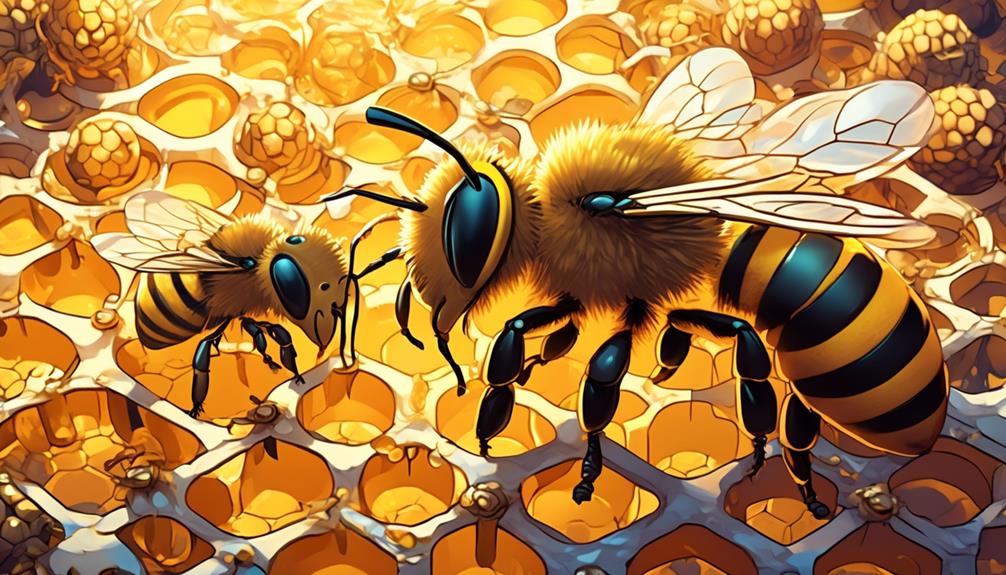
While understanding the distinctive effects of bee stings and bites is crucial, it's equally important to debunk some of the prevalent myths about bee behavior.
First, contrary to popular belief, not all bees die after stinging. It's primarily honeybees that meet this fate, as their stingers are barbed and often get stuck in mammalian skin, causing fatal damage when they pull away. Other bee species can sting multiple times without harm to themselves.
Secondly, bees aren't inherently aggressive. They usually sting or bite only when they perceive a threat to their hive or themselves. Remember, their primary roles are pollination and honey production, not attack. So, if you're calm and non-threatening, you're less likely to provoke them.
Lastly, it's a myth that bees are attracted to sweet scents. They're actually drawn to floral fragrances, which they associate with nectar. Wearing sweet-smelling perfumes or lotions doesn't necessarily make you a bee magnet.
It's essential to approach bees with respect and understanding, recognizing the vital role they play in our ecosystem. By debunking these myths, you're better equipped to peacefully coexist with these industrious insects.
Frequently Asked Questions
What Are the Different Types of Bees and Do They All Have the Ability to Bite or Sting?
You're right to wonder about the types of bees and their abilities to bite or sting.
Over 20,000 bee species exist, each with unique characteristics.
Honeybees, for instance, can sting, but they'll die afterwards.
Bumblebees also sting but won't die.
Some species, like the stingless bees, can only bite.
However, it's important to note that bee bites aren't common and usually only happen when they're seriously threatened.
How Can One Treat a Bee Bite or Sting at Home?
To treat a bee sting at home, first, you'll need to remove the stinger. Use a flat edge, like a credit card, to scrape it out. Don't squeeze it, you'll just pump more venom in.
Then, wash the area with soap and water. Apply a cold pack to reduce swelling.
Over-the-counter pain relievers and antihistamines can help with pain and itching.
If you're feeling dizzy or having trouble breathing, seek medical help immediately.
Are There Any Specific Seasons When Bees Are More Likely to Bite or Sting?
Yes, there are certain seasons when you're more likely to be stung by bees. Bees are most active during the warmer months, specifically spring and summer, as they're out foraging for nectar and pollen.
During these times, you're more likely to accidentally disturb a bee and provoke a sting. However, it's important to remember that bees don't typically sting unless they feel threatened.
What Are the Potential Allergic Reactions to a Bee Bite or Sting?
When you're stung by a bee, you might experience an allergic reaction. This can range from a mild local reaction, causing swelling and redness, to a more severe systemic reaction.
In the latter case, you could experience symptoms like difficulty breathing, hives, a rapid pulse, and dizziness. The most severe reaction is anaphylaxis, which is life-threatening and requires immediate medical attention.
Always seek medical help if you've been stung and are feeling unwell.
How Can One Prevent Bee Bites or Stings While Outdoors?
You can prevent bee bites or stings by following these precautions:
- Avoid wearing bright clothing or floral perfumes, as they attract bees.
- Don't walk barefoot in grass, as bees often forage there.
- Keep food and drinks covered when outdoors.
- If a bee approaches, stay calm and slowly move away. Disturbing a bee may provoke it.
- Using insect repellent and wearing protective clothing can also be beneficial.
- Lastly, avoid areas where you know bees are nesting or swarming.
Conclusion
In conclusion, bees can't technically bite the way we understand it. Their anatomy is designed to sting, not bite. Any biting notion is often confused with their nectar siphoning mouthparts.
The effects of a bee sting are significantly more severe than a so-called bite. It's important to debunk misconceptions about bee behavior, as understanding them better promotes coexistence and fosters a healthier environment.

